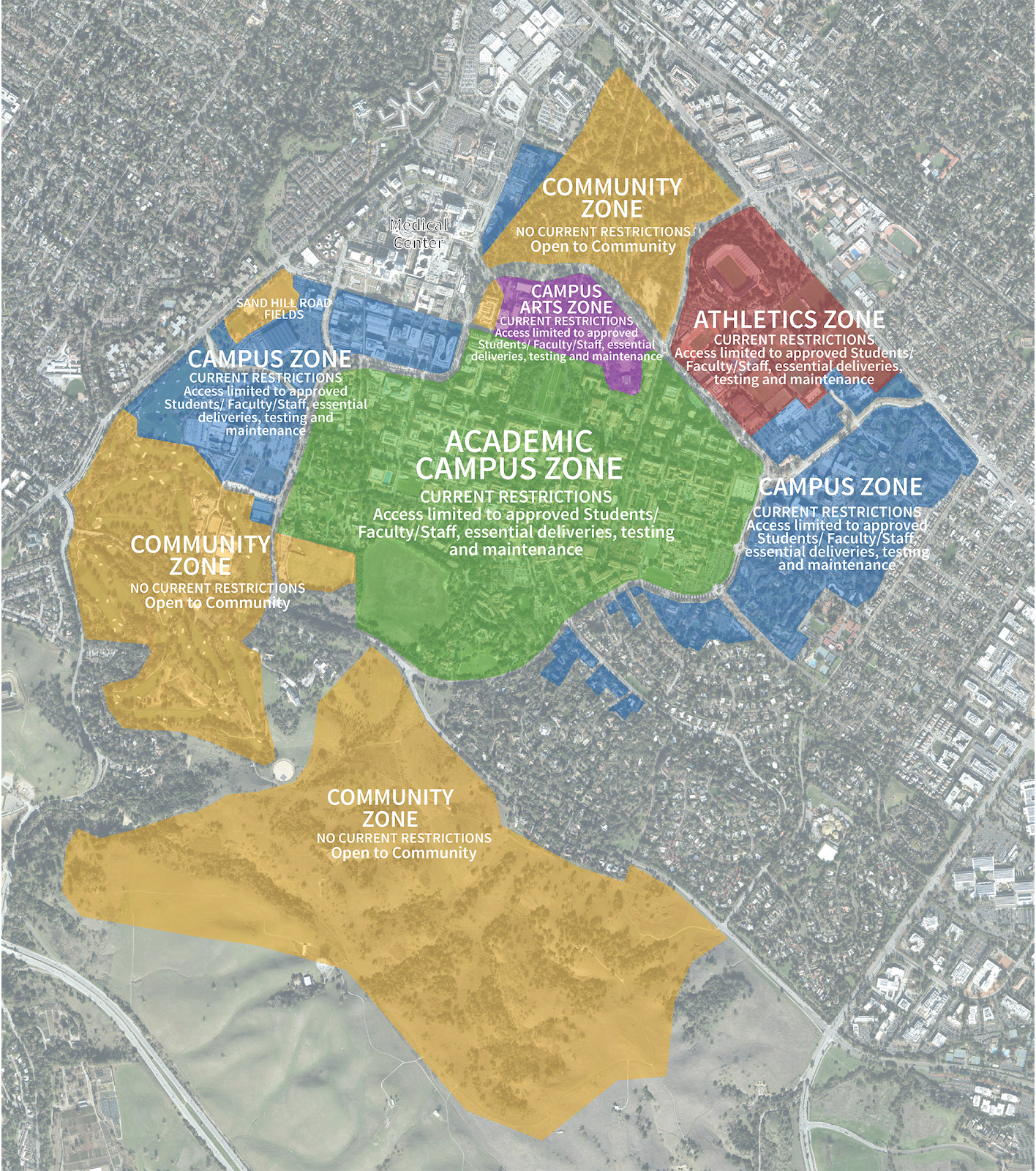Stanford is establishing a temporary “campus zones program” that will define access to its main campus, effective Sept. 1. Stanford community members approved to be on campus will be required to visibly display their Stanford IDs when in controlled zones starting on Sept. 8.
The temporary zones will be implemented in order to reduce contact between “nonessential visitors” and individuals approved to be on campus, according to President Marc Tessier-Lavigne’s Friday email.
Areas designated as “Community Zones,” which include the Dish area, Stanford Golf Course and the Arboretum, will remain open to the public. The zone system does not extend to the University’s Redwood City campus, Stanford Health Care facilities and the faculty subdivision.
In an Aug. 13 email to the community, Stanford announced that only approved students with special circumstances would be allowed on campus during autumn quarter. “Undergraduate students who are not living on campus will not be allowed to come to campus,” the email read.
The decision comes in light of state guidance issued on Aug. 7 that requires colleges and universities in California to “limit, to the greatest extent permitted by law, external community members from entering the [campus] and using campus resources, as the number of additional people onsite and/or intermixing with students, faculty and staff increases the risk of virus transmission.”
County guidance that prohibits most indoor classes and the use of indoor common space has further necessitated these restrictions, allowing Stanford to increase the availability of outdoor classrooms and workplaces according to Associate Director of Community Engagement Communications Joel Berman.
Beginning on Sept. 8, the campus zones program will require students, faculty and staff in controlled zones to have their Stanford IDs visible. Tessier-Lavigne said that Stanford will supply lanyards to make it easier for community members to display their IDs.
Although most undergraduate education will be remote, the University is expecting up to around 6,300 students, including graduate students and undergraduates with special circumstances, to be on campus for the fall quarter, according to the email.
Stanford safety personnel will be stationed at gathering spaces in restricted zones, including the Oval, Lake Lagunita and Meyer Green. Those who do not display their Stanford ID or are unable to show that they are approved to be in a specific zone will be asked to leave campus or move to an unrestricted zone.
If individuals do not comply with requests to leave restricted zones, or if they repeatedly violate campus zone policies, they could be cited for trespassing. Tesser-Lavigne wrote in his email that it is “important to emphasize that the focus of the zones program is educational and health-promotional, not punitive.”
Undergraduate Senators raised concerns in the spring that an increased police presence on campus might lead students of color to feel anxious and threatened.
“Students of color are constantly stopped to show ID,” a second-year grad student, who was granted anonymity at the time for privacy reasons, told The Daily in July. “Once students prove themselves, police give back-handed compliments. ‘We don’t see too many women of color grad students around here. Good for you.’ Then there are stories of white students walking home, and police laughing with them. They say, ‘enjoy your night.’”
University spokesperson E.J. Miranda told The Daily that “Stanford is committed to implementing the campus zones program in a way that respects all members of our community, and especially those most impacted by persistent societal issues related to equity and justice.”
Miranda did not comment on whether safety personnel would include officers in the Department of Public Safety or how the ID policy would be enforced among Stanford affiliates.
Different areas of the main campus will be classified as one of five types of zones: Academic Campus Zone, Campus Zone, Athletics Zone, Campus Arts Zone, and Community Zone.
The Academic Campus Zone, Campus Zones, Athletic Zone and Campus Art Zone will be limited to approved students, faculty, staff and other Stanford affiliates, while Community Zones will be open to the public.
Even though many of the controlled zones have similar restrictions, the University says that it is “maintaining distinct designations to preserve greater flexibility to adjust restrictions in different parts of campus as public health conditions improve.”
The Academic Campus Zone, enclosed by Roth Way and Campus Drive, comprises academic buildings, the Main Quad and the Oval.
The University also announced the removal of visitor parking in the Academic Campus Zone, which will be strictly enforced.
Tessier-Lavigne wrote that the University is seeking “suggestions for how the campus zones can be improved” and is “committed to a collaborative effort that complies with county and state public health orders, while also striving to meet the needs of the Stanford community and allow our neighbors to enjoy parts of campus.”
Contact Cameron Ehsan at cehsan ‘at’ stanford.edu.
